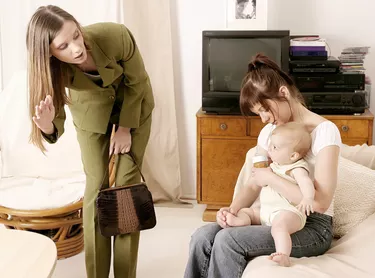
Hiring a caregiver from overseas requires following both immigration and tax law. If you break the law, even unintentionally, you may face hundreds of dollars in fines. Worse, if immigration arrests a caregiver who's not in the country legally, your child or dependent could be left alone until you get home.
Bringing Him Here
Video of the Day
To bring the caregiver here, you can use the H-2B or J-1 visa. The H-2B works if you have someone specific you want to employ. You apply to the Department of Labor for temporary employment certification and then submit a petition to Immigration. If everything goes smoothly, the government issues the visa. However the government only allows 66,000 H-2B visitors each year. If the State Department has already issued the maximum, you'll have to wait until next year.
Video of the Day
You're Now an Employer
With a J-1 visa, you work with one of various government-designated sponsors who bring foreigners into the US as "au pair" caregivers. You don't get to pick the individual in advance, but the program has strict standards. Participants have to be proficient in English, between 18 and 26 years old, and a high school graduate or the equivalent. Someone in the sponsoring organization will interview each candidate and you'll get a chance to read the interview before accepting her. J-1 applicants have to pass a background check.
Taxes and Withholding
When you have a live-in caregiver in your house, you're officially an employer. If your new employee wants you to withhold income tax, you can, but it's not mandatory. You must take out Social Security and Medicare if you pay him -- as of 2014 -- $1,900 or more. The total tax is 15.3 percent of wages, with you and your employee each paying half the amount. You may also have to take out for unemployment insurance. IRS Publication 926 provides full instructions for household employers.
Tax Breaks for You
If your live-in caregiver is watching over a child under 13, or a spouse or dependent who can't care for herself, you may qualify for a tax credit. The Child and Dependent Care credit is available if you need the caregiver's services to work or job-hunt. If you're married, both you and your spouse must need the service for those reasons. The largest possible credit is based on up to $3,000 worth of expenses if the caregiver watches one person or up to $6,000 for two or more. You multiply this dollar amount by a certain percentage based on our own income -- between 20 and 35 percent -- to calculate the actual credit.